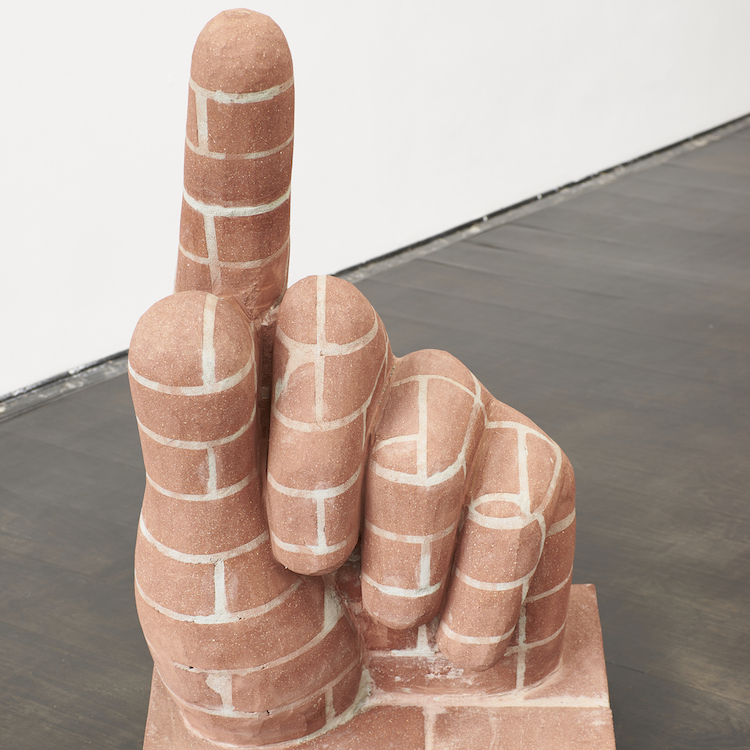MÜNCHEN, Germany — Berlin-based artist Judith Hopf’s latest exhibition Judith: Up at Deborah Schamoni featured (February 2 – April 15, 2017) surprisingly fluid and rounded sculptures — all made from a traditionally rigid material.
Above image: Judith Hopf, Hand 3 (Pointing Hand), 2017, Bricks, cement, 41 x 24 x 15 inches.
In a conversation with Sabeth Buchmann, Hopf explains her hands and the other sculptures are made of industrially made bricks which are juxtaposed against the form the she shapes from them.
Buchmann: Bricklike hands waving at them, sculptures standing like skeletal bodies in the room. Your recent works continue the mixture of alternating geometric abstraction and figuration, object and subject, that is familiar from the genre of comics, and which I also recognize in your Wartende Laptops (Waiting Laptops) and Erschöpfte Vasen (Exhausted Vases): apparatuses and objects with psychological quirks that remind us of ourselves and hence of the question of why we see and feel that which we see and feel, and how we see and feel it. Always a trace too unstable to pass as entirely self-confident “works,” they could be regarded as replacements or placeholders for ourselves: They seem to ask how art could be created beyond the continual reproduction of the forms intended for it in order to touch on the often unclarified relationship we have to it.

Judith Hopf, Hand 4 (Waving Hand) (detail), 2017, Brick, cement, 45.7 x 31 x 12 inches. Click for larger image
Hopf: First the bricks were formed into various cuboids, and then their forms were hewn out and separated. The bricks used were all originally made of clay, of course, but they were industrially produced and hence are a standardized size. Any attempt to make a perfect, geometric form, such as a cuboid, from clay by hand will probably fail. By contrast, the effort to make regular bricks of clay and to make or fire them using technology has been a cultural challenge since time immemorial.
It seems we have solved that, at least, today: bricks are technically perfect. They form a regular, repeating pattern when they are laid, and, in the service of architectural requirements (if one has learned the skilled craft of masonry) they form perfect lines and flat surfaces.
From an artistic perspective, these contemporary bricks, with their rigid appearance, also have an inherent Donald Judd–like quality. As so often, my sculptures struggle through my fascination for modernity, through the gullies of minimalist art and systems of reference in order to pin their aesthetic experiments with “emptying” to something new or different: for example, the nonfunctioning wheels and parts of a trolley that are produced by pressing clay together. For me, the comic-like quality you mention has less to do with the form of the objects and sculptures than with the narrative level that seems to sneak into all my objects.
Text from “Loose Forms. Judith Hopf in Conversation with Sabeth Buchmann” in Judith Hopf: UP (Mousse Publishing, 2016)
Do you love or loathe these brick works from the worlds of contemporary ceramic art and contemporary ceramics? Let us know in the comments.





Add your valued opinion to this post.